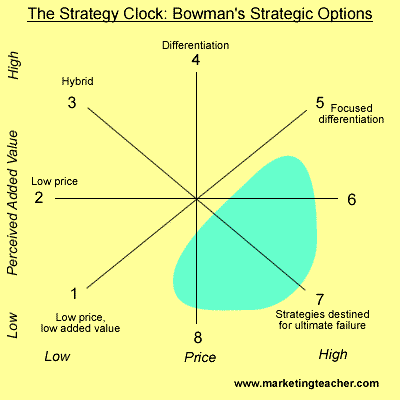Bowman’s Strategy Clock
The Strategy Clock: Bowman’s Competitive Strategy Options
The ‘Strategy Clock’ is based upon the work of Cliff Bowman (see C. Bowman and D. Faulkner ‘Competitve and Corporate Strategy – Irwin – 1996).
Bowman’s Strategy Clock is a framework developed by Cliff Bowman and David Faulkner to help businesses analyze their competitive position in the market and identify potential strategic options. The model is based on two key dimensions: price and perceived value, which are plotted on a clock face with 12 positions.
The 12 positions on the clock represent different strategic options, ranging from low-price/low-value strategies to high-price/high-value strategies. Each position on the clock has its own set of advantages and disadvantages, and different companies may choose to adopt different strategies depending on their competitive position, market conditions, and other factors.

The Bowman’s Strategy Clock is a popular framework in business strategy and has been widely used in both academic and practical settings. It is often used to evaluate the competitive position of a company in relation to its competitors and to identify potential strategic options for the future.
Option one – low price/low added value
- likely to be segment specific.
Option two – low price
Option three – hybrid
- low cost base and reinvestment in low price and differentiation.
Option four – differentiation
(a)without a price premium:
- perceived added value by user, yielding market share benefits.
(b)with a price premium:
- perceived added value sufficient to to bear price premium.
Option five – focussed differentiation
- perceived added value to a ‘particular segment’ warranting a premium price.
Option six – increased price/standard
- higher margins if competitors do not value follow/risk of losing market share.
Option seven – increased price/low values
- only feasible in a monopoly situation.
Option eight – low value/standard price
- loss of market share.
It’s another suitable way to analyze a company’s competitive position in comparison to the offerings of competitors. As with Porter’s Generic Strategies, Bowman considers competitive advantage in relation to cost advantage or differentiation advantage. There are six core strategic options:
References:
- Bowman, C., & Faulkner, D. (1996). The essence of competitive strategy. Prentice Hall.
- Johnson, G., Whittington, R., & Scholes, K. (2011). Exploring strategy: text and cases. Pearson Education.
